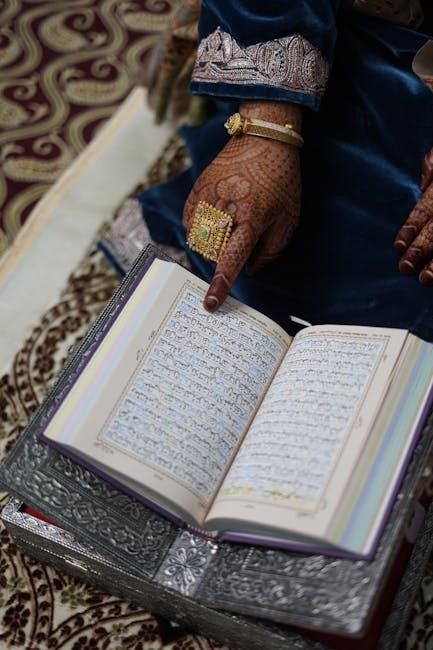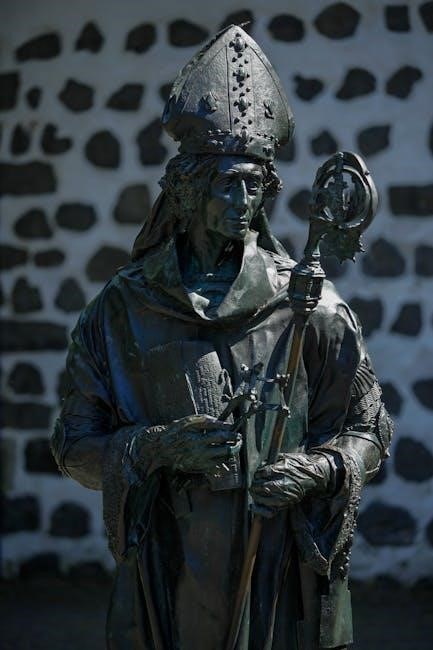
The Book of Ruth is a captivating narrative about Ruth, a loyal Moabite woman, her journey with Naomi, and her marriage to Boaz, set during Israel’s judges period.
1.1 Background and Overview
The Book of Ruth is a historical narrative set during the time of the judges in Israel, a period marked by spiritual and moral decline. The story revolves around Naomi, an Israelite, and her Moabite daughter-in-law Ruth, who return to Bethlehem after a time of famine and personal loss. The book highlights themes of loyalty, faith, and redemption as Ruth commits to Naomi and her God, leading to her marriage with Boaz, a wealthy relative. This beautifully crafted story bridges the era of the judges and the monarchy, linking Ruth to the lineage of King David and, ultimately, Jesus Christ.
1.2 Key Themes and Messages
The Book of Ruth emphasizes themes of loyalty, devotion, and redemption. Ruth’s unwavering commitment to Naomi exemplifies selfless love and faith amidst adversity. The story highlights God’s grace and providence, as Ruth, a foreigner, is integrated into Israel’s community and lineage. It underscores the importance of family, covenant faithfulness, and divine sovereignty in shaping human lives. The narrative also reflects the cultural and religious significance of kindness, humility, and trust in God, offering timeless lessons for believers across generations.

Historical Context of the Book of Ruth
The Book of Ruth is set during the era of the Judges, a time of spiritual turmoil in Israel, yet it highlights loyalty and divine grace.
2.1 The Time Period of the Judges
The Book of Ruth is set during the era of the Judges, a period marked by spiritual turmoil and moral decline in Israel. This time, described in the Book of Judges, was characterized by a cycle of sin, punishment, repentance, and deliverance. The phrase “every man did what was right in his own eyes” encapsulates the chaotic nature of this era. Despite the darkness, the story of Ruth shines as a beacon of hope, illustrating loyalty, faith, and divine grace amidst the moral and spiritual decay of the nation.
2.2 Authorship and Composition
The authorship of the Book of Ruth is traditionally attributed to the prophet Samuel, though the text itself does not explicitly name the writer. Composed after the anointing of David, the book skillfully weaves a narrative of faith, loyalty, and divine grace. Its literary style is renowned for its beauty and simplicity, making it one of the most celebrated short stories in biblical literature. The genealogy at the end highlights Ruth’s connection to David and, ultimately, to Jesus, underscoring its theological significance in both Jewish and Christian traditions.

Main Characters in the Book of Ruth
The Book of Ruth centers on three key figures: Ruth, a loyal Moabite widow; Naomi, her grieving Israelite mother-in-law; and Boaz, a noble kinsman-redeemer.
3.1 Ruth: The Moabite Woman
Ruth, a Moabite woman, is the central figure of the book. Initially an outsider, she becomes a symbol of loyalty and faith through her devotion to Naomi. After her husband’s death, Ruth chooses to remain with Naomi, embracing her people and God. Her bravery and humility lead her to encounter Boaz, a kinsman-redeemer, who marries her. Ruth’s journey exemplifies divine grace and redemption, as she becomes part of King David’s lineage, ultimately contributing to the ancestry of Jesus Christ. Her story highlights the transformative power of faith and loyalty.
3.2 Naomi: The Israelite Mother-in-Law
Naomi, an Israelite, is a central figure in the Book of Ruth, embodying resilience and faith amidst adversity; Originally from Bethlehem, she moves to Moab with her family due to famine. After losing her husband and sons, Naomi returns to Bethlehem with her daughter-in-law Ruth, expressing bitterness over her losses. Her journey reflects a transformation from despair to hope as she witnesses God’s providence through Ruth’s loyalty and Boaz’s kindness. Naomi’s story highlights the complexities of human emotion and the divine plan unfolding in her life, ultimately leading to redemption and grace.
3.3 Boaz: The Redeemer
Boaz, a wealthy and righteous Israelite, plays a pivotal role as the kinsman-redeemer in the Book of Ruth. He first encounters Ruth when she gleans in his field, demonstrating kindness by allowing her to gather grain. Boaz’s integrity and faith shine as he protects Ruth and shows compassion to Naomi. His redemption of Naomi’s land and marriage to Ruth underscore his role as a divine provider. Through Boaz, God weaves a story of grace, ultimately linking Ruth to King David’s lineage and Jesus Christ. Boaz’s actions exemplify loyalty, honor, and trust in God’s plan. His character remains a testament to faith and redemption.

Central Themes Explored
The Book of Ruth explores themes of loyalty, redemption, grace, and divine providence, showcasing how God works through ordinary lives to fulfill His extraordinary plan, emphasizing faith and trust.
4.1 Loyalty and Devotion
Ruth exemplifies unwavering loyalty and devotion through her commitment to Naomi. Despite facing widowhood and cultural barriers, she chooses to remain with her mother-in-law, declaring her allegiance to Naomi’s God and people. This steadfast dedication highlights the power of personal commitment and intergenerational bonds, reflecting the deep trust in divine providence. Ruth’s actions emphasize the transformative influence of loyalty, making her a timeless example of faith and devotion in the face of adversity.
4.2 Redemption and Grace
The Book of Ruth beautifully illustrates redemption and grace through Boaz’s role as the kinsman-redeemer. He restores Naomi’s land and marries Ruth, a foreigner, showcasing divine grace. This act of redemption highlights God’s faithfulness and inclusion of Gentiles in His plan. Ruth’s integration into Israel’s lineage reflects the broader theological theme of redemption, ultimately pointing to Jesus as the supreme Redeemer. The story underscores how grace transcends cultural and ethnic boundaries, offering hope and belonging to those on the margins.
4.3 Cultural and Religious Significance
The Book of Ruth holds profound cultural and religious significance, highlighting the inclusion of Gentiles in God’s plan. Ruth, a Moabite, becomes part of David’s lineage, symbolizing God’s grace beyond Israel. Her story reflects the value of loyalty, faith, and trust, resonating deeply in Jewish and Christian traditions. The narrative underscores themes of divine providence and redemption, emphasizing God’s faithfulness to His people. Ruth’s journey from outsider to ancestor of the Messiah illustrates the universal scope of God’s redemption, making it a cornerstone of biblical theology and a testament to His inclusive love.

Genealogy and Its Importance
The Book of Ruth highlights Ruth’s journey from a Moabite woman to her integration into King David’s lineage, ultimately connecting to Jesus Christ, emphasizing divine redemption and cultural significance.
5.1 The Lineage of David
The Book of Ruth intricately weaves Ruth’s story into Israel’s royal lineage, revealing her as the great-grandmother of King David. This Moabite woman, through her marriage to Boaz, becomes an ancestor of Israel’s most revered leader. Her inclusion in David’s lineage underscores God’s redemptive plan, extending beyond cultural boundaries. Ruth’s loyalty and faithfulness not only secure her place in the family of Naomi but also in the lineage of Jesus Christ, highlighting divine grace and the unity of God’s people across nations and generations.
5.2 The Ancestry of Jesus Christ
Ruth’s marriage to Boaz and the birth of Obed, their son, places her in the lineage of Jesus Christ. As the great-grandmother of King David, Ruth becomes a vital link in the Messianic lineage. The genealogy in Matthew 1:5-6 highlights Ruth’s inclusion, showcasing God’s plan to incorporate Gentiles into His covenant people. Her story exemplifies divine grace, as a foreigner is brought into the family of God, ultimately contributing to the birth of Jesus. This underscores the theme of redemption and God’s universal plan of salvation, bridging cultural and religious divides.

Narrative Structure of the Book
The Book of Ruth is a concise narrative set during the judges’ period, focusing on the lives of Ruth, Naomi, and Boaz, illustrating divine providence.
6.1 Chapter-by-Chapter Breakdown
The Book of Ruth is divided into four chapters, each highlighting key events in Ruth’s journey. Chapter 1 introduces Naomi’s family moving to Moab and their return to Bethlehem after loss. Chapter 2 focuses on Ruth gleaning in Boaz’s field, showcasing her kindness and Boaz’s generosity. Chapter 3 details Naomi’s guidance for Ruth to secure a future, leading to Ruth’s marriage proposal to Boaz. Chapter 4 concludes with Boaz redeeming Naomi’s land and marrying Ruth, culminating in the birth of Obed, linking Ruth to David’s lineage and ultimately to Jesus.
6.2 Literary Style and Technique
The Book of Ruth is renowned for its concise yet powerful narrative style, often described as one of the most beautifully crafted short stories in the Bible. It employs dialogue effectively to reveal character traits, such as Ruth’s loyalty and Boaz’s kindness. The story’s structure builds tension and resolution, emphasizing themes like redemption and divine providence. Despite its brevity, the text is rich in emotional depth, exploring relationships and cultural nuances. Its literary skill lies in its ability to weave profound theological truths into a relatable human story, making it a timeless example of narrative excellence.

Key Events and Turning Points
- Ruth’s journey from Moab to Bethlehem with Naomi.
- Ruth gleans grain in Boaz’s field, initiating their relationship.
- Boaz redeems Naomi’s land and marries Ruth, securing their future.
7.1 The Journey from Moab to Bethlehem
The journey of Naomi and Ruth from Moab to Bethlehem marks a pivotal moment in the narrative. Faced with hardship and loss, Naomi returns to Bethlehem with her daughter-in-law Ruth, who vows loyalty. This transition symbolizes trust in God’s providence amidst uncertainty; The journey underscores Ruth’s devotion and Naomi’s resilience, setting the stage for divine intervention in their lives. It highlights themes of faith, loyalty, and redemption, central to the story’s theological depth.
7.2 The Encounter in Boaz’s Field
Ruth’s encounter with Boaz in his field marks a turning point in the narrative. While gleaning grain, Ruth’s humility and diligence catch Boaz’s attention. Boaz, a kinsman of Naomi, shows compassion by offering Ruth food and protection. This meeting underscores divine providence and sets the stage for their eventual marriage. Ruth’s loyalty to Naomi and her faith in God are rewarded through Boaz’s kindness, illustrating the theme of grace and redemption. The encounter highlights the importance of human kindness and God’s sovereignty in shaping their lives.
7.3 The Redemption and Marriage
The redemption and marriage of Ruth and Boaz is a pivotal moment in the narrative. Boaz, as Naomi’s kinsman-redeemer, legally redeems Elimelech’s land and marries Ruth. This union, blessed by God, results in the birth of Obed, grandfather of David. Ruth’s faith and loyalty are rewarded as she enters the lineage of Israel’s greatest king and ultimately Jesus. The marriage symbolizes divine grace and redemption, showcasing God’s faithfulness in transforming tragedy into triumph. Naomi, once bitter, finds joy through Ruth’s steadfast love and Boaz’s kindness, highlighting the theme of God’s providential care.

Theological and Spiritual Lessons
The Book of Ruth teaches about faith, loyalty, and divine providence. It emphasizes God’s grace in redemption and the importance of trust in His sovereignty, inspiring believers to live faithfully.
8.1 Faith and Trust in God
Ruth’s story underscores the power of unwavering faith and trust in God amidst adversity. Despite losing her husband and facing uncertainty, Ruth chose to remain loyal to Naomi and trust in God’s providence. Her faith was evident in her willingness to glean in Boaz’s field, relying on God’s provision. The narrative highlights how Ruth’s trust in God led to divine intervention, resulting in her marriage to Boaz and her integration into God’s plan. This teaches believers to trust God during difficult times, knowing He works sovereignly for their good and His glory. Ruth’s faith serves as a timeless example of reliance on God.
8.2 The Concept of the Kinsman-Redeemer
The Book of Ruth illustrates the biblical concept of the kinsman-redeemer, a family member responsible for restoring the lineage and inheritance of a relative in need. Boaz, as Naomi’s kinsman, fulfills this role by marrying Ruth and redeeming Naomi’s land, ensuring the continuation of Elimelech’s family line. This theological theme highlights God’s providential care and redemption, as Boaz’s actions mirror the ultimate redemption through Jesus Christ, the true Kinsman-Redeemer, who restores humanity’s spiritual inheritance. The narrative underscores the importance of family, responsibility, and divine sovereignty in redemption.

Cultural and Historical Impact
The Book of Ruth has profoundly shaped Jewish and Christian traditions, inspiring countless works of art, literature, and theological reflection, emphasizing its enduring cultural significance.
9.1 Influence on Jewish Tradition
The Book of Ruth holds a significant place in Jewish tradition, often read during the Festival of Shavuot, which commemorates the giving of the Torah. Its themes of loyalty, conversion, and divine providence resonate deeply, making it a cherished text in Jewish culture. The story of Ruth’s voluntary adoption of Judaism has shaped Jewish perspectives on conversion and inclusion. The book’s emphasis on family, faith, and redemption aligns with core Jewish values, making it a vital part of Jewish heritage and education for generations.
9.2 Role in Christian Theology
The Book of Ruth plays a vital role in Christian theology, as it prefigures the ultimate redeemer, Jesus Christ. Ruth’s story, through her marriage to Boaz, symbolizes the kinsman-redeemer theme, which points to Christ’s redemption of humanity. Her inclusion in the lineage of David and Jesus highlights God’s grace and plan of salvation for all nations; The book underscores themes of faith, loyalty, and divine providence, inspiring believers to trust in God’s sovereignty. It also emphasizes the universal scope of God’s plan, showing that salvation extends beyond Israel to the Gentiles, reflecting the inclusive nature of Christ’s redemption.

Modern Relevance and Applications
The Book of Ruth offers timeless lessons on trust, kindness, and resilience, inspiring modern readers to embrace faith, loyalty, and hope in their personal and communal lives.
10.1 Lessons for Contemporary Life
The Book of Ruth offers timeless lessons for modern life, emphasizing the importance of loyalty, trust, and resilience. Ruth’s unwavering devotion to Naomi and her faith in God’s providence inspire believers to remain steadfast in their own challenges. The story highlights the value of kindness, humility, and community, encouraging readers to embrace hospitality and compassion. Additionally, Ruth’s journey underscores the strength of women in shaping families and societies, making it a powerful narrative for empowerment. These themes resonate universally, providing guidance for navigating life’s complexities with grace and hope.
10.2 Inspirational and Moral Teachings
The Book of Ruth provides profound moral and inspirational teachings, emphasizing the power of faith, loyalty, and selflessness. Ruth’s unwavering commitment to Naomi and her trust in God’s plan exemplify the transformative impact of devotion. The story highlights the importance of integrity, kindness, and humility, as seen in Boaz’s compassionate actions. It also underscores the universal value of love and acceptance, transcending cultural and religious boundaries. These teachings inspire readers to embrace moral virtues and trust in divine providence, offering hope and guidance for living a purposeful and ethical life.
Leave a Reply
You must be logged in to post a comment.